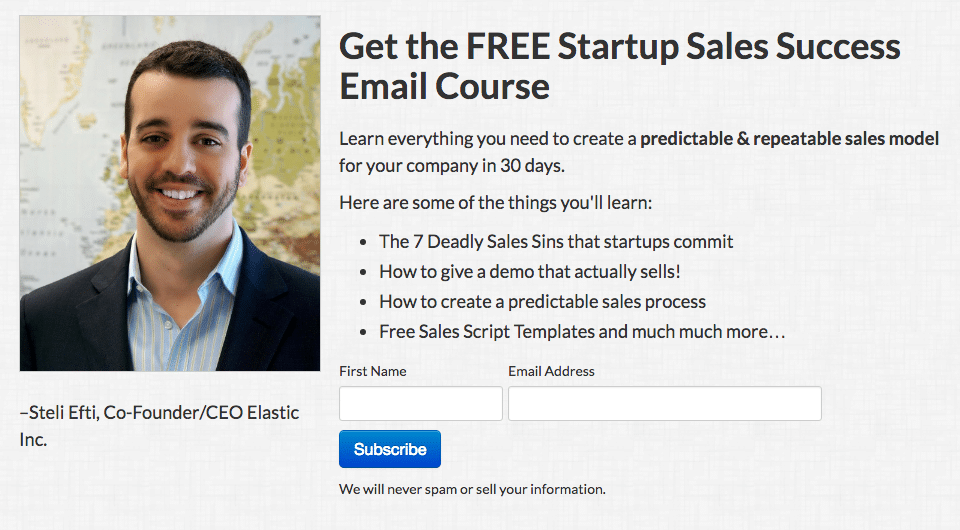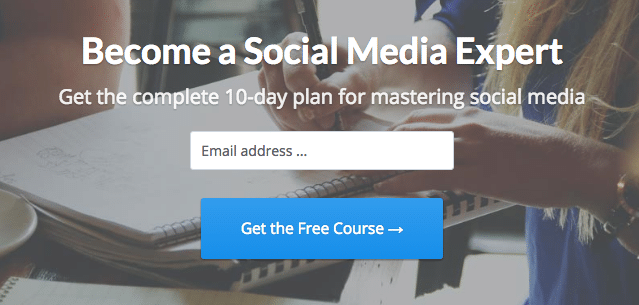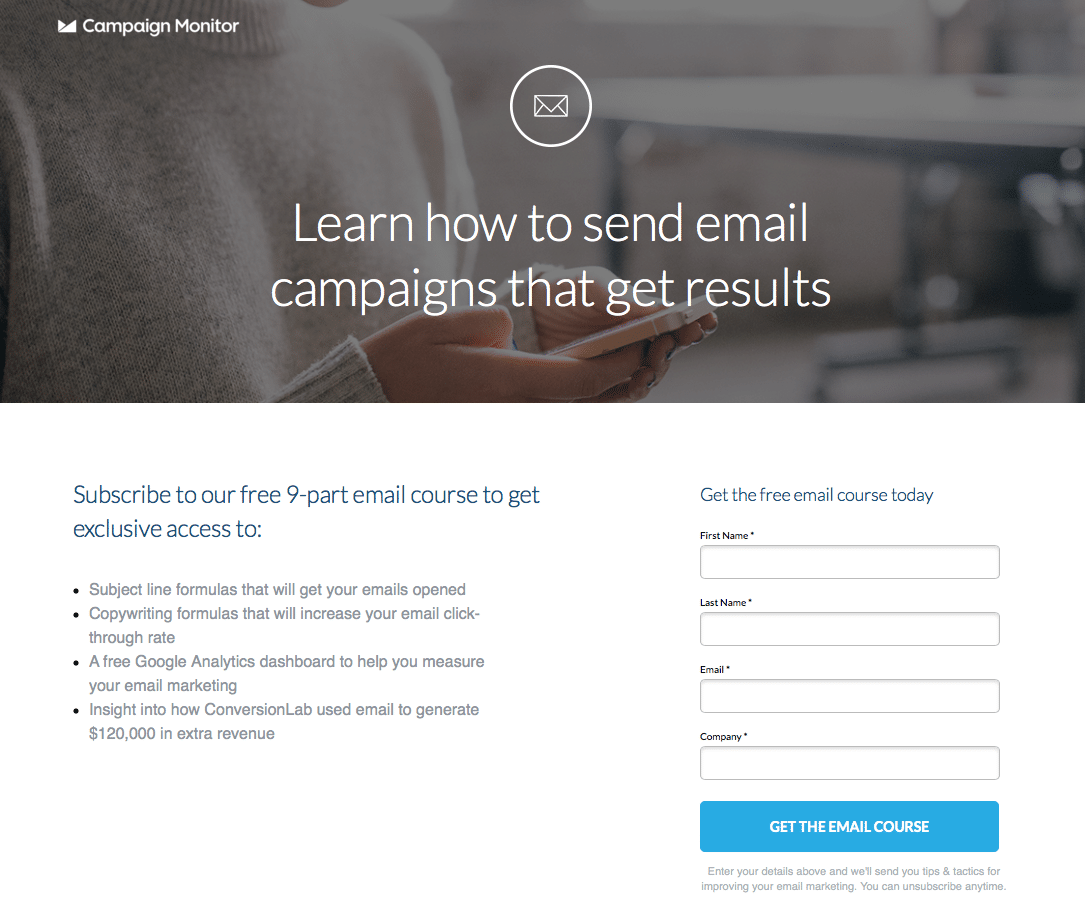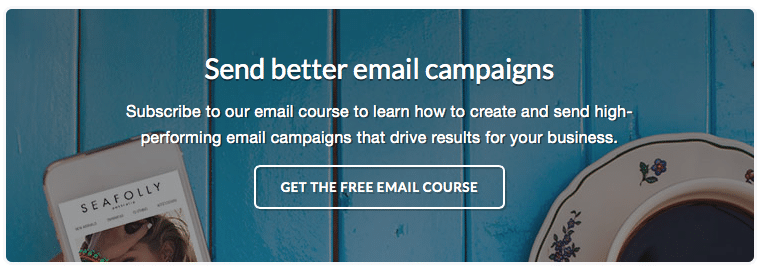Article first published May 2016, updated May 2019
In the new era of email marketing, marketers are intent on delivering subscribers exactly what they want, when they want to receive it. And technology is paving the way: email automation and personalization allow marketers to create enticing campaigns that engage subscribers.
At Campaign Monitor, we’re big believers in the power of automated email courses—as well as other types of automated email series—to do exactly that.
Email courses are gaining traction, particularly for B2B organizations that need to educate their audiences in order to make a sale, but also with B2C companies who want to provide curated content to their customers. In an email course, subscribers sign up to receive daily, weekly, or monthly emails to educate them on a topic. It’s like a helpful, tailored blog series that goes straight to their inbox where they already spend so much time.
Email courses encourage engagement and help generate familiarity with your brand. They also build trust and prove that you care about your audience for more than just their wallets.
How can you, as a marketer, get started with email courses? In this post, we’re sharing 5 things you should know when creating an automated email series.
How does an automated email series work?
An automated email series relies on automation. A subscriber signs up for your course and then receives emails on a scheduled basis that you’ve clearly defined and explained beforehand.
This sign up triggers your automated series to deliver content to your subscribers, providing them with knowledge on a topic on which you’re an authority.
Email courses can function independently from other email marketing efforts and be highly targeted to certain groups. For example, you could create an email course for new customers to help them get onboard with your service. You could also have an email course that gives prospective customers fresh insights into your industry to help boost your authority in the space.
But these aren’t the only reasons to have an email course. You can also take a page from girlboss and create a course that you know your audience will be interested in. They partnered with BlackRock to create a course that teaches subscribers about finances:
Campaign Monitor email courses
An email course to teach marketers how to get results
At Campaign Monitor, we have an automated email course aimed at helping marketers interested in learning more about email marketing. We send 9 lessons to help marketers learn how to send email campaigns that get results.
When a subscriber signs up, they receive emails on a timely basis that teach them a variety of tactics:
Lesson 1: Ideas for great subject lines
Lesson 2: Copywriting tips and tricks
Lesson 3: Free sites to get amazing images for email campaigns
Lesson 4: How to use a Google Analytics Dashboard with email marketing
Lesson 5: How we got a 127% increase in click-throughs by redesigning our email template
Lesson 6: How ConversionLab used email to turn lost website visitors into $120,000 in revenue
Lesson 7: How BuzzFeed uses email marketing to drive phenomenal growth
Lesson 8: How to integrate business apps with your email marketing tool
Lesson 9: How to choose the right email marketing software for your business
We know people who visit our site are interested in learning more and this course makes it simple. This course consistently sees incredibly high engagement, so we know our audience is interested and hungry for more information on this topic.
Small business email marketing course
We also have an email course that teaches small businesses how to get started with email marketing. We know email marketing has the power to lead small businesses to achieve their biggest and most audacious goals, so we designed an email course to help all of our subscribers do just that.
The course walks subscribers step by step through all the most confusing aspects of email marketing so that, by the time they’re done, they are ready to tackle email marketing with confidence.
These courses are designed with the sole purpose of helping our audience tackle problems and feel confident doing so.
5 tips to create a high-performing automated email course
But how do we decide when to create an email course and what topic to cover?
Here’s how we create our email courses.
1. Choose a subject that excites your audience
The point of an email course is for your audience to learn something they don’t already know, but care about learning. You need to be very deliberate about choosing a subject, just as you would when considering curated content.
You can start by looking at content that’s performed well on your blog, doing some keyword research, or talk to customers about what their biggest pain points are. Many companies repurpose content from their blog or knowledge-bases in their email courses.
Close.io, a CRM targeted at small sales teams, created an email course on startup sales, precisely because the team knew that’s what the audience cared about most. The course consisted of 13 emails, and most had open rates that exceeded 55%.

Buffer has a number of email courses, including Become a Social Media Expert, a 10-day email course to help marketers learn more about social media. The course includes info on when to post, how to post, and what types of reports to show your boss.
This is a particularly good subject for Buffer to focus on as their product is a social media scheduling software.

2. Promote your email course like it’s a product
It’s a good start to create an email course, especially if you already have the content. But if you want to be successful, you have to promote your email course as though it’s a product.
That means you need to design and build a convincing landing page, consider paying for promotion on social media, and add CTAs at the end of your blog posts to encourage your readers to sign up.
At Campaign Monitor, we promote our email course via CTAs at the end of relevant blog posts that lead to a landing page where people can sign up.
The CTA looks like this:
And the landing page looks like this:

Much like a product, your email course can continue to reap benefits long after you’ve created it. Once you have the email course set up, you can use it to educate customers for a substantial period.
3. Focus on the content
If you’re going to do an email course, you have to make sure your emails are a pleasure to read. Content is key to creating a high-performing email course. You can’t just slap something together.
Instead, your email course needs to contain top-notch content, from your visuals to the actual copywriting.
To do this, we recommend employing copywriting principles and spending significant time crafting your lessons.
Here are a few copywriting hacks to try:
- Use the PAS formula
- Experiment with A/B testing
- Use a “from name” that’s a real person
- Employ the 5 persuasion techniques: sensory words, evoke imagination, add the word ‘because’ and formulate sound bites.
4. Don’t overwhelm readers with too much copy
When your subscribers sign up for an email course, they’re looking to gain specific information. Don’t overwhelm them with too much content or content that isn’t exactly what you promised them it would be.
You need to be respectful of your subscribers and deliver on your promises when you do business and running an email course is no different.
That means keeping your emails short and being transparent about how many emails they’ll receive. We let subscribers know from the get-go how many lessons each course has and when to expect them in their inbox.
5. Give subscribers the next step when the course ends
There’s a reason to create email courses, and that’s to provide value to your subscribers. If you want your course to leads to conversions—however you define them—then you must direct subscribers to a next step.
Maybe you encourage them to get in touch with your sales team, sign up for another course, read more about a specific topic, subscribe to your email newsletter, share the course on social media, or read a landing page about what services you offer.
But whatever you do, don’t leave them hanging: The end of your course is a perfect opportunity to re-engage your subscribers.
At the end of the Campaign Monitor email course, we offer subscribers the opportunity to sign up for a free account.
Wrap up
An automated email series like an email course educates your audience so they can make informed decisions and feel confident. An email course will show that you’re an authority in the space and get subscribers familiar with your brand.
When it comes time to make a purchase, your students will be more likely to choose you.







